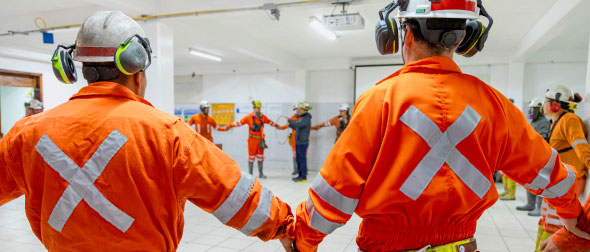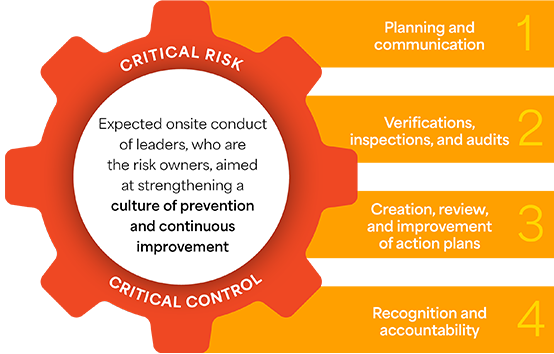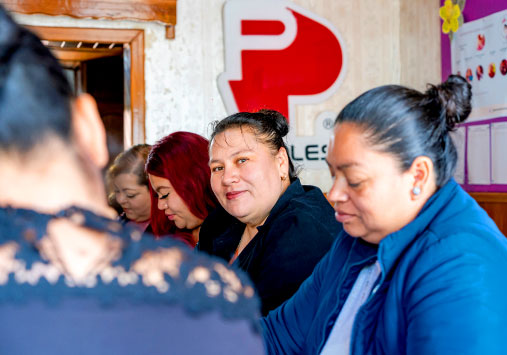
Social

Social
Human rights
Impact and risk management
We responsibly manage activities in our business model and value chain that may affect human rights. When it comes to impact and risk management, our position is clear: we ensure that human rights are respected and enforced in our operations and with our stakeholders—employees, unionized personnel, contractors, and the communities where our operating units are located.
The table below identifies the potential impacts on the most relevant human rights, taking into account our stakeholders and business model, and the sections of the report that document the measures we take to prevent and mitigate them—both in our own activities and in our value chain.
Risk management
Based on the Universal Human Rights Compendium, in 2023 we developed a Human Rights Risk Catalog using the ESG risk management methodology (see ESG Risk Management section). A multidisciplinary team evaluated these risks to obtain the baseline that will enable us to take actions and establish measures and control mechanisms to prevent, detect or correct situations.


| Relevant human rights potential impacts | Additional information about our activities: |
|---|---|
| Right to life | Safety and health section |
| Right to safe access to water | Water stewardship section |
| Right to safe, equitable, and healthy working conditions | Comprehensive well-being Safety and health section |
| Right to freedom from slavery | Value chain section Our people section |
| Right to freedom of association | Strong correlation section |
| Rights of indigenous peoples |
Human rights Indigenous peoples Living the Community section |
During 2023, there were no legal actions related to extortion, abuse, discrimination, forced or compulsory labor, unfair labor practices, indigenous rights, or any other complaint related to human rights.

Diversity, equity, and inclusion

Culture Assessment

“Women for women” Mentoring Program

DEI Master Class for Executives

Labor Equality and
Non-discrimination Policy

Labor Equality and
Non-discrimination Committee
| Pay gap by hierarchical level | ||||
|---|---|---|---|---|
| Hierarchical level | Pay gap (ratio) of women vs. men | Women | Men | |
| Senior positions | 0.95 | 21% | 79% | 100% |
| Professional | 0.98 | 23% | 77% | 100% |
| Non-professional | 1.06 | 25% | 75% | 100% |
| Breakdown by hierarchical level | ||
|---|---|---|
| Hierarchical level | Women | Men |
| Senior positions | 27.68% | 30.64% |
| Professional | 53.87% | 53.59% |
| Non-professional | 18.45% | 15.77% |
| 100% | 100% | |
Workforce
Percentage of women


Total percentage of women

* The drop in the total percentage of women is due to a decline in the percentage of women contractors.

Safety and health
Strategy
High Potential Management strategy
We are continually and systematically working to reduce high potential and catastrophic incidents that have a significant impact on health or even fatalities. Our strategy is to focus on three processes that must be continuously improved—which strengthen each other and are supported by visible leadership:

Safety impact and risk management
Health impact and risk management
In 2023, we devised a plan of ongoing hygiene studies to update risk maps and redefine our classification of groups with similar exposures, while reinforcing the occupational health-monitoring program with a battery of studies on specific risks through the mainstream standard of oversight. This strengthens our preventive approach to safety by focusing on controlling the work environment (levels N3 and N4 of the health risk management model).

Our high potential and critical risk strategy aims for a goal of zero harm in our activities.

Community
Life cycle engagement
Our community engagement strategy is tailored to community expectations and potential impacts at each stage of the mining and metals life cycle.
Social Performance Standard
Our standard establishes the criteria and success factors for responsibly managing social impacts and risks, so we can earn the communities’ trust in our operations and projects and execute our business strategy.


Main Social Management Tools

Communities: Positive Social Impacts
Social investment and shared value
Our social investment portfolio—which is aligned with the SDGs—fosters mutual understanding and a harmonious relationship with communities, stronger relations of trust and shared responsibility, development of local capacities, and productive alliances with civil society organizations; all for the purpose of creating social well-being.

Education

Health and sports

Skill building

Access to water